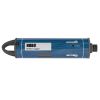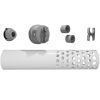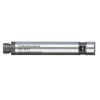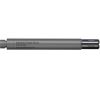Onset HOBO CTD Sensors
Features
- 4-electrode conductivity sensor provides wide measurement range for monitoring freshwater or saltwater
- Durable ceramic water level sensor, located in the sensor tip for accurate measurement of shallow water levels
- Get water level directly with the MX802, no need for post-processing
- Free ground shipping
- Expedited repair and warranty service
- Lifetime technical support
- More
The CTD sensor is an interchangeable sensor that works with HOBO MX800 Series Water Loggers to measure conductivity, temperature, and water level. With this sensor attached to a HOBO MX800 Series Water Logger, the logger can also calculate specific conductance, salinity, and total dissolved solids (TDS).
The CTD sensor can be attached directly to the fully submersible MX801 model, or attached via cable to the direct read MX802 model, which doesn’t require having to pull the sensor out of the water to download data.
| Sensor | |
| Dimensions | 2.5 cm (1 inch) diameter, 15 cm (6 inches) length |
| Weight | Approximately xx g (xx oz) in air; approximately xx g (xx oz) in saltwater |
| Wetted Materials | Passivated 316 Stainless steel housing rated for use in saltwater, Viton and Buna-N O-rings, PET sensor connector |
| Conductivity sensor: PET, platinum plating on electrodes | |
| Note: Sensor should be mounted so that it is not in contact with other metals | |
| Environmental Rating | IP68; Waterproof to 100m |
| Conductivity Measurements | |
| Measurement Range | Electrical conductivity and specific conductance: 0 to 100,000 µS/cm |
| Salinity using PSS-78: 2 to 42 PSU | |
| Total Dissolved Solids (TDS): 0 to 100,000 mg/L | |
| Calibration Range | Electrical conductivity: 50 to 80,000 µS/cm |
| 5° to 35°C (41° to 95°F) | |
| Accuracy | Conductivity: +/-2% or 15 µS/cm whichever is greater |
| Salinity: +/-2% of reading or 0.1 PSU, whichever is greater | |
| Resolution | Conductivity:0.1 µS/cm from 0 to 1,000 µS/cm | 1 µS/cm from 1,000 to 10,000 µS/cm |10 µS/cm from 10,000 to 100,000 µS/cm |
| Salinity: 0.01 PSU | |
| TDS: 0.1 mg/L | |
| Response Time | 1 second to 90% at a stable temperature |
| Temperature Measurements | |
| Range | -20° to 50°C (-40° to 122°F), non-freezing water |
| Accuracy | ±0.15°C (±0.27°F) from 0° to 50°C (32° to 122°F) |
| Resolution | 0.01°C at 25°C (0.018°F at 77°F) |
| Response Time | 3 minutes to 90% in water (typical) |
| Drift | <0.1°C (0.18°F) per year |
| Absolute Pressure and Water Level Measurements W-CTD-04 | |
| Range | 0 to 145 kPa (0 to 21 psia); approximately 0 to 4 m (0 to 13 ft) of water depth at sea level, or 0 to 7 m (0 to 23 ft) of water at 3,000 m (10,000 ft) of altitude |
| Factory Calibrated Range | 69 to 145 kPa (10 to 21 psia), 0° to 40°C (32° to 104°F) |
| Burst Pressure | 310 kPa (45 psia) or 18 m (60 ft) depth |
| Water Level Accuracy* | Typical error: ±0.075% FS, 0.3 cm (0.01 ft) water |
| Maximum error: : ±0.15% FS, 0.6 cm (0.02 ft) water | |
| Raw Pressure Accuracy** | ±0.3% FS, 0.43 kPa (0.063 psi) maximum error |
| Resolution | <0.014 kPa (0.002 psi), 0.14 cm (0.005 ft) water |
| Pressure Response Time*** | <1 second to 90% at a stable temperature |
| Absolute Pressure and Water Level Measurements W-CTD-01 | |
| Range | 0 to 207 kPa (0 to 30 psia); approximately 0 to 9 m (0 to 30 ft) of water depth at sea level, or 0 to 12 m (0 to 40 ft) of water at 3,000 m (10,000 ft) of altitude |
| Factory Calibrated Range | 69 to 207 kPa (10 to 30 psia), 0° to 40°C (32° to 104°F) |
| Burst Pressure | 310 kPa (45 psia) or 18 m (60 ft) depth |
| Water Level Accuracy* | Typical error: ±0.05% FS, 0.5 cm (0.015 ft) water |
| Maximum error: ±0.1% FS, 1.0 cm (0.03 ft) water | |
| Raw Pressure Accuracy** | ±0.3% FS, 0.62 kPa (0.09 psi) maximum error |
| Resolution | <0.02 kPa (0.003 psi), 0.21 cm (0.007 ft) water |
| Pressure Response Time*** | <1 second to 90% at a stable temperature |
| Absolute Pressure and Water Level Measurements W-CTD-02 | |
| Range | 0 to 400 kPa (0 to 58 psia); approximately 0 to 30.6 m (0 to 100 ft) of water depth at sea level, or 0 to 33.6 m (0 to 111 ft) of water at 3,000 m (10,000 ft) of altitude |
| Factory Calibrated Range | 69 to 400 kPa (10 to 58 psia), 0° to 40°C (32° to 104°F) |
| Burst Pressure | 500 kPa (72.5 psia) or 40.8 m (134 ft) depth |
| Water Level Accuracy* | Typical error: ±0.05% FS, 1.5 cm (0.05 ft) water |
| Maximum error: ±0.1% FS, 3.0 cm (0.1 ft) water | |
| Raw Pressure Accuracy** | ±0.3% FS, 1.20 kPa (0.17 psi) maximum error |
| Resolution | ±0.3% FS, 1.20 kPa (0.17 psi) maximum error |
| Pressure Response Time*** | <1 second to 90% at a stable temperature |
| Absolute Pressure and Water Level Measurements W-CTD-03 | |
| Range | 0 to 850 kPa (0 to 123.3 psia); approximately 0 to 76.5 m (0 to 251 ft) of water depth at sea level, or 0 to 79.5 m (0 to 262 ft) of water at 3,000 m (10,000 ft) of altitude |
| Factory Calibrated Range | 69 to 850 kPa (10 to 123.3 psia), 0° to 40°C (32° to 104°F) |
| Burst Pressure | 1,200 kPa (174 psia) or 112 m (368 ft) depth |
| Water Level Accuracy* | Typical error: ±0.05% FS, 3.8 cm (0.125 ft) water |
| Maximum error: ±0.1% FS, 7.6 cm (0.25 ft) water | |
| Raw Pressure Accuracy** | ±0.3% FS, 2.55 kPa (0.37 psi) maximum error |
| Resolution | <0.085 kPa (0.012 psi), 0.87 cm (0.028 ft) water |
| Pressure Response Time*** | <1 second to 90% at a stable temperature |
| *Water Level Accuracy: With accurate reference water level measurement, known water density, and a stable temperature environment. System Water Level Accuracy equals the sum of the Barometric Water Level Accuracy plus the selected CTD sensor Water Level Accuracy. | |
| ** Raw Pressure Accuracy: Absolute pressure sensor accuracy includes all sensor drift, temperature, and hysteresis-induced errors. | |
| ***Changes in Temperature: Allow 20 minutes in water to achieve full temperature compensation of the pressure sensor. There can be up to 0.5% of additional error due to rapid temperature changes. | |
In The News
Monitoring and Facilitating Habitat Restoration Efforts in the Great Lakes
While human infrastructure, urbanization, and industrialization have advanced human societies, the natural environment has suffered due to constructed impediments and deteriorating architecture. In order to combat this degradation, habitat restoration programs across the US work to remove impairments and improve damaged waterways. [caption id="attachment_39162" align="aligncenter" width="940"] Barge electrofishing by state and federal employees prior to habitat restoration on Wiscoy Creek which is a tributary to the Genesee River. (Credit Thomas Hoffman)[/caption] Habitat Restoration Efforts in the Great Lakes Tom Hoffman, aquatic habitat restoration biologist in the Lower Great Lakes basin, directs restoration efforts within tributaries to Lake Erie, Lake Ontario, and the St.
Read MoreSustainable Fishing in Alaska: Protecting the Salmon Capital of the World through Research
In the far north, the Alaska Peninsula stretches away from the Last Frontier into the Pacific Ocean. A narrow strip of land dotted with freshwater lakes and intruded upon by ocean inlets–this unique region is intimately connected with the surrounding water. Nestled halfway down the peninsula's southern coast are the small villages of Chignik. The area has historically been home to the Aleut people and has been heavily reliant on fishing for centuries. Home to commercial and subsistence fishing today, Chignik continues to rely upon the salmon returns to the surrounding villages, which are supported by scientists working tirelessly to understand and steward these fish populations.
Read MoreNexSens X3 Data Logger Review
Extreme environments meet extreme design with the NexSens X3 Data Logger . The new logger offers the latest in real-time monitoring technology with wireless communication, a large plug-and-play sensor library and ultra-low power consumption, all in a waterproof marine-grade housing. The X3 is built to handle harsh weather, floods, high winds and rough seas, and it stands alone; no additional protective housing needed. With an operating temperature that ranges from -40°C to 70°C, the logger can withstand arctic environments and extreme heat. A conformal coating on the internal circuit board isolates it from moisture and humidity.
Read More
































